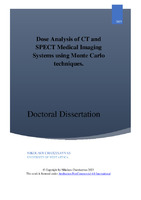| dc.description.abstract | An addressing of questions about the methodologies, strategies, optimizations, and approaches used to assess dosimetric data in Computed Tomography (CT) and Single Photon Emission Computed Tomography (SPECT) systems was primarily the purpose of this thesis. The key task throughout the study time was to evaluate the two dissimilar systems, understand their principles of operation, and eventually apply Monte Carlo software to imitate them and monitor outcomes from the standpoint of dosages. All trials were composed, validated, and explored using cutting-edge, primarily open-source Monte Carlo software. The software packages Geant4, GATE, and EGSNRC, as well as auxiliary scripts to assess, transform, and analyze simulated inputs and outputs were successfully configured and built in most cases from source code. The correct configuration and installation of all packages in an Ubuntu 20.04 environment was a difficult task, owing to the involvement of several programming languages, including Fortran, C/C++, Java, and Python, as well as the fact that most software packages were built from source code, requiring the use of numerous packages, compilers, and builders. An extensive installation instruction for configuring, building and installing all software packages utilized are given in Appendix2. The CT system was configured by simulating various x-ray sources, creating personalized phantoms from patient-specific examinations (DICOM format), and scoring doses on those phantoms by simulating x-ray source irradiation circularly from all angles (360O). Tungsten (W) and gold (Au) anode target materials were used, and each anode target material was simulated in the energy range of 30 keV–150 keV with a step of 5 keV. Overall, 50 beams (25 for W and 25 for Au) were simulated once the x-ray source characteristics were determined. The EGSnrc software was used to execute the simulations, and the output files for each beam simulation were saved in binary phase space file format. Many elements of the x-ray source also have a substantial influence on the quality of the beam and thus the dosage received by such a complicated piece of equipment. For the SPECT system, a new approach was employed. Since the source (radiopharmaceutical-isotope) is injected directly into the patient and is irradiated from within the body as it travels within the patient, it was difficult to simulate such an operation in the same way as the CT. Following the injection, the patient is placed on the SPECT bed where the imaging system takes shots- projections, circularly from all angles, and a sinogram is created as an output. Finally, specialized algorithms reconstruct the raw data, sinogram, into a 3D picture which provides valuable information to the doctors. The approach was to simulate a whole SPECT system, in which different SPECT system factors impacting the image's quality as well as the characteristics of the reconstruction processes producing the image were explored. The open-source program GATE was used in collaboration with STIR to reconstruct the image from the raw output data provided by GATE simulation. The filtered back projection (FBP) and iterative approach of Ordered Subsets Maximum A Posteriori One Step Late (OSMAPOSL) algorithms were supplied by STIR. | el |


